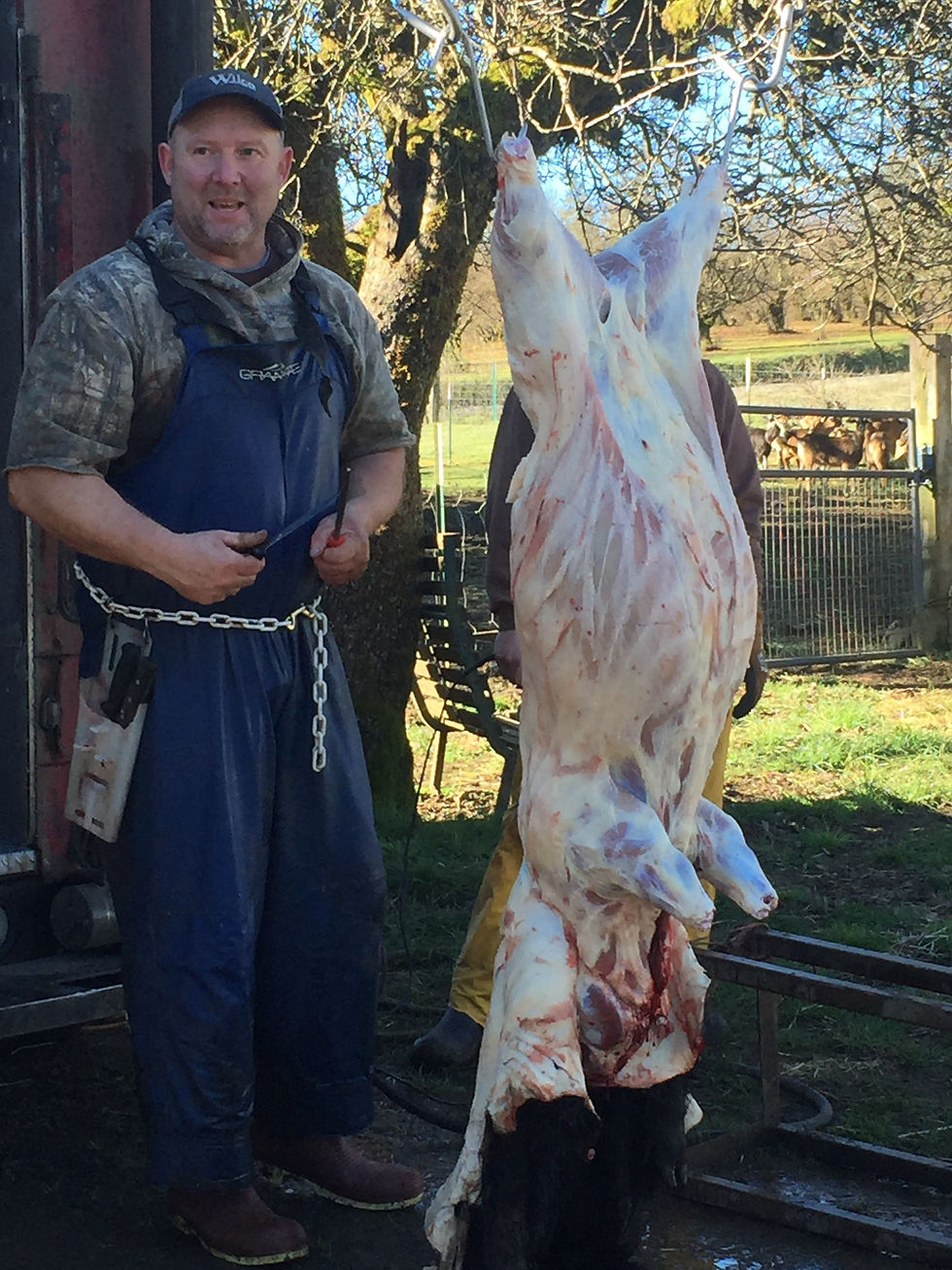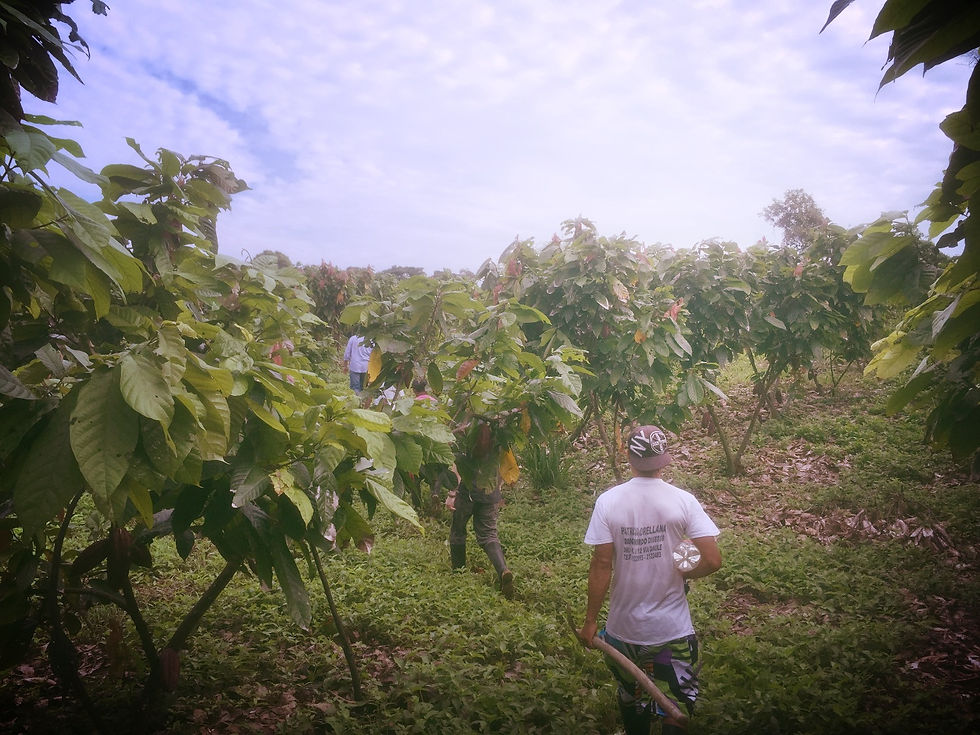What to Read: For the Hog Killing by Wendell Berry, & Where to Read It: Forest Grove, OR
- Maura Jean
- Oct 11, 2018
- 6 min read
Read this poem before the hog killing while working on a goat farm outside Portland
For the Hog Killing
Wendell Berry
Let them stand still for the bullet, and stare the shooter in the eye,
let them die while the sound of the shot is in the air,
let them die as they fall, let the jugular blood spring hot to the knife,
let its freshet be full,
let this day begin again the change of hogs into people,
not the other way around,
for today we celebrate again our lives’ wedding with the world,
for by our hunger, by this provisioning, we renew the bond.
*Note: This post contains what may be disturbing images to some, including the butchering of animals
The first time I encountered the butchering of an animal was in Colorado. It was on a farm in Gunbarrel, just outside of Boulder and was run by a man named Alec Solimeo. People paid him to start farms on their property. This one was twelve acres with about two acres farmed with an incredibly diverse array of vegetables, fruits and herbs. They also had pigs, goats, and about 70 free range chickens so wild that they nested in the trees instead of in their cozy, fenced-in coop.

On the morning of the chicken slaughter, I woke up early and I ran. I went to a coffeeshop, went out to eat, but all I day I couldn’t stop thinking about what was going on back at the farm. I was supposed to be there, and I had simply not shown up to work that day. I finally returned around 3 o’clock, expecting the killing to be over, but it wasn’t. They were still processing chickens. There was a metal cone hung up on a shed, and they took the chickens one by one and placed them head first in the cone and then slit their throats. The blood was drained into orange buckets set up beneath them. They were then put through a spinning device that removed all of their feathers. The naked carcasses were then placed in an ice bath, wrapped in plastic, but in boiling water, and then put in the ice bath again to seal the plastic. They were then frozen to be sold. Meat bees swarmed, and I was stung twice that day.

Alec’s friend came to help process them. He had raucous curly hair and wild eyes, and refused to let me escape so easily. He immediately began ribbing me for running as soon as I showed up. Alec didn’t say anything, but I knew that they were all thinking the same thing. I am a meat eater, and yet I couldn’t face the slaughter.
I talked to Alec later that day, and he told me something that I’ve never forgotten: those chickens lived a completely free life in a beautiful place, and they had one bad day. Their last day was a horror of being rounded up and waiting in a cage to be slaughtered one by one. They knew what was coming too. Their was an air of death over the farm that day, and no one was shying away from it.
Years later, working on a goat farm in Forest Grove, Oregon, about 45 minutes west of Portland, I encountered my second slaughter. I was working for a German woman named Lise. She was tiny and extremely formidable. She had an encyclopedic knowledge about the world’s injustices, real estate, tax law, politics, and organic farming practices. I spent hours talking to her over a huge copper bowl as we stirred goat milk caramel. She taught me how to milk goats, how to bring them up into the milking parlor and place my hand on their udders to calm them before milking. She taught me how to connect the pipes to the bulk tank where the milk was kept, how to muck out the barn, how much alfalfa to feed them, how to drain cysts that sometimes developed on the goats’ sides. Every month, she cooked a huge meal and took it down to a highway bridge in Portland where she set out a long table with a tablecloth and flowers and candlelight and served the homeless. She cared tirelessly for her profoundly disabled son, Kyle, who could not speak, could barely move, and required round-the-clock care. She was an incredible woman who lived in relentless understanding of the world’s suffering and injustice.

Besides around sixty or seventy goats, there were also three heritage pigs on the farm. One of them was pregnant when I arrived and we were anxiously awaiting the piglets. I slept in a room above the barn and for weeks, I would wake in the night to the sound of the pig screaming and wonder if she was finally giving birth. Then one day, she was simply not pregnant any more, but had no piglets to show for it.
James Joyce said that Ireland is like a sow that eats her farrow. I’d never known this to be a real phenomenon, but pigs, above all, are pragmatists. This is why they can be so revolting to us. They will eat anything, including their own children. Maybe she had her babies while in the forest when all of the livestock were let out to pasture and she realized she couldn’t bring them back to the farm. It was still snowing and cold, maybe she feared that she wouldn’t be able to sustain them with her own precious nutrients. Either way, she ate her own babies.
A couple of weeks later, the kids began to come. The goats began having babies, sometimes five or six kids being born every day. It was astounding to watch these impossibly fragile-looking, stick-legged babies come bleating into the world. Within fifteen minutes, they had stood. Watching them raise themselves on their matchstick legs, falling over multiple times before finally holding themselves up on their shaking hooves, and then seeing them nurse within the first half hour, filled me with awe. The kids were being born so quickly and in such high numbers that we had to put little kitten collars on them with bells and numbers so that we would know which mother they belonged to be sure they were nursing.


They would bounce around and kick their hind legs to make their bells ring, jumping and dancing joyfully to the sound. They were soft and loved being held and scratched. Having watched them struggle to be born, and having watched their mothers suffer bringing them into the world, I cherished every one.
One day, a terrible cry went up in the barn. By the time we came in, the pig had dismembered two kids, pulling off those fragile legs that had supported their weight so improbably.
Lise said that was it. She called the butcher that day and set up an appointment for the following Tuesday for all the pigs to be slaughtered. That morning, I’d forgotten that the pigs were going to be killed. I did the morning milking, and came outside around ten o’clock to see that a large truck with a bright red trailer had pulled into the driveway beside the pig pen. A middle aged man and his daughter got out, both of them wearing yellow Wilco overalls. He carried a gun. All at once, I remembered: the pigs were going to be slaughtered.

My co-worker and I stood outside, watching. Lise came out with several pieces of paper. She had printed out copies of Wendell Berry’s “For the Hog Killing” for all of us, including the butchers themselves. We read it in silence.
“Let them stand still for the bullet.”
The pigs did not move. They walked right up to the man with a gun and stared trustingly up at him as he shot them. They were dead before they had hit the ground, their bodies twitching.
The butcher put a hook into them and dragged them out of the pen. He placed them in a metal trough so that their legs were sticking up in the air. He cut off their hooves, skinned them, and removed their organs. Then he lifted them up with a hydraulic system where they hung gutted inside his refrigerated trailer. He repeated this twice more until all of the pigs were hanging. His daughter cried during the slaughter.
And I watched the whole thing. While my hand didn’t wield the knife, I didn’t turn away. I could have started crying at any point during the slaughter but I didn’t. I’d scratched these pigs behind their ears, fed them twice a day everyday, brought them our scraps, watched them run screeching indignantly from the Great Pyrenees that lived with the goats. I knew the personality of these pigs, and I watched then die.

Wendell Berry’s “For the Hog Killing” made their death sacred. It turned “hogs into humans instead of the other way around” as we rendered their lard, ate their meat, and did not shy away from the reality of death. Far from losing our humanity, it solidified it as we remembered the sacrifices that give us our sustenance.



Comments